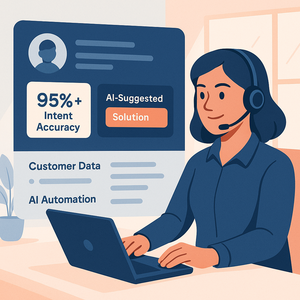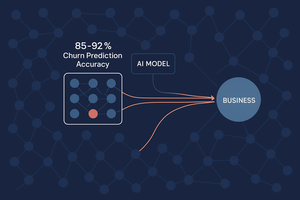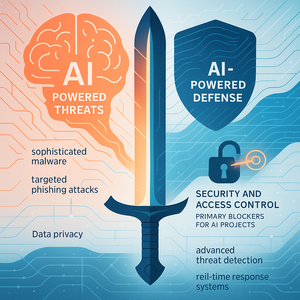Navigating the AI Transformation Tightrope: Balancing Innovation, Regulation, and Human Capital
The artificial intelligence landscape in late 2025 presents a complex picture of immense opportunity tempered by significant operational challenges....
7 min read
 Peter Vogel
:
Oct 21, 2025 12:10:17 AM
Peter Vogel
:
Oct 21, 2025 12:10:17 AM

The discourse surrounding artificial intelligence is maturing. Across boardrooms and operational teams, the conversation has decisively shifted from speculative potential to the practical realities of strategic implementation. This evolution presents both a significant opportunity and a complex challenge for business leaders. No longer is it enough to simply acknowledge AI's disruptive power; the imperative now is to embed it responsibly and effectively into the very fabric of the organisation to drive tangible value.
This article moves beyond the headlines to analyse five critical areas of AI development that demand the attention of today's business leaders. We will distil complex trends into actionable intelligence for Operations and Technology Executives, Marketing Leaders, and Growth-Focused CEOs. Our analysis focuses on the strategic ‘how’—how to harness generative AI in marketing without sacrificing brand integrity, how to bolster cybersecurity with intelligent systems, and how to build governance frameworks that foster trust and ensure compliance.
For leaders tasked with driving efficiency, securing competitive advantage, and navigating regulatory landscapes, this briefing provides a clear-eyed view of where AI is creating the most impact. We will explore the latest advancements in Generative AI for Marketing, AI-Powered Cybersecurity, AI-Driven Supply Chain Optimisation, Responsible AI Governance, and AI-Augmented Customer Service, equipping you with the insights needed to lead your organisation's transformation journey.

The integration of generative AI into marketing is rapidly moving past the experimental phase, becoming a cornerstone of high-performing campaign strategies. For marketing departments under pressure to deliver more personalised content across a growing number of channels, these tools are no longer a luxury but a critical enabler of efficiency and scale. The focus is now on embedding this technology into workflows to augment human creativity, not replace it.
Recent advancements in large language models (LLMs) have dramatically improved their ability to produce structured, brand-aligned outputs. New features that allow for strict schema definitions can reduce post-processing and editing requirements by as much as 60% (OpenAI, 2025), allowing marketing teams to accelerate the creation of everything from ad copy to social media updates. Furthermore, with modern AI-powered data extraction systems achieving an average accuracy rate of 95.7% (Global AI Insights, 2025), organisations can more effectively analyse customer data to inform and personalise this new wave of content at an unprecedented scale.
However, this rapid adoption is not without its challenges. Maintaining brand voice consistency across all AI-generated content requires robust guidelines and human oversight. There are also significant considerations around data privacy, copyright of training data, and the ethical implications of AI-generated imagery. The most forward-thinking organisations are not just adopting the tools but are building comprehensive frameworks to govern their use, ensuring that efficiency gains do not come at the cost of brand reputation or customer trust.

As cyber threats grow in sophistication and volume, traditional, rule-based security systems are proving insufficient. In response, AI and machine learning have become indispensable assets for creating proactive, adaptive cybersecurity postures. These systems can analyse vast datasets in real time, identifying anomalous patterns and potential threats that would be impossible for human analysts to detect.
The latest AI-powered security platforms are transforming incident response. By automating the extraction and standardisation of data from network logs and access reports, these systems can process security events up to 400 times faster than manual approaches (Forrester, 2025), which is critical in mitigating the impact of a breach. Leading solutions establish a baseline of ‘normal’ organisational behaviour and automatically flag deviations, enabling security teams to focus on the most credible threats.
Despite these advantages, implementation requires careful planning. Integrating AI security tools with legacy IT infrastructure can be complex, and teams must be trained to interpret AI-generated alerts effectively. A persistent challenge is managing the risk of model degradation; without continuous evaluation, AI models in production can experience an average performance decline of 23% over 12 months (MIT Technology Review, 2025). This underscores the need for ongoing monitoring to ensure the system remains effective against evolving attack vectors.

The fragility of global supply chains, exposed by recent geopolitical and economic volatility, has accelerated the push for greater resilience and efficiency. AI is at the heart of this transformation, offering organisations the ability to move from reactive problem-solving to proactive, predictive optimisation across logistics, inventory management, and demand forecasting.
The true power of AI in the supply chain lies in its ability to extract and standardise data from a multitude of disconnected sources. The implementation of standardised data extraction has been shown to reduce data entry errors by a remarkable 89%, leading to more reliable analytics (Gartner, 2025). In the manufacturing sector, the adoption of new protocols for standardising data from Industrial IoT devices has enabled early adopters to improve the accuracy of their predictive maintenance models by 45% (Manufacturing Technology Centre, 2025), significantly reducing unplanned downtime.
The primary challenge for many organisations is overcoming data silos and integrating AI solutions with legacy Enterprise Resource Planning (ERP) systems. Ensuring high-quality, standardised data is the foundational step upon which all successful AI-driven supply chain initiatives are built. This often requires a significant initial investment in data infrastructure and governance before the full benefits of predictive analytics can be realised.

As AI systems become more autonomous and integral to core business functions, establishing robust governance frameworks is no longer a matter of best practice, but a business and regulatory necessity. The implementation of regulations like the EU AI Act has formalised the need for organisations to ensure their AI systems are transparent, fair, and accountable.
Effective AI governance is built on a foundation of structured evaluation. Leading AI-first companies now allocate 15-20% of their AI development budget specifically to model evaluation and testing (McKinsey, 2025). This involves moving beyond simple performance metrics to rigorously assess models for bias, fairness, and explainability. Research shows that organisations implementing structured evaluation frameworks with standardised criteria report a 42% reduction in selection bias compared to unstructured approaches (Harvard Business Review, 2025), demonstrating the tangible impact of a disciplined governance process.
The primary challenge lies in translating high-level ethical principles into concrete operational policies and technical controls. This requires a cross-functional effort to define acceptable risk thresholds, establish clear lines of accountability, and implement mechanisms for ongoing monitoring. Without such a framework, organisations expose themselves to significant reputational, financial, and legal risks.

Customer expectations for immediate, personalised, and effective service have never been higher. AI-augmented automation is emerging as the only scalable way to meet these demands while managing operational costs. The goal is not to eliminate the human element, but to empower service teams by automating routine inquiries and providing agents with the data-driven insights needed to handle complex issues more effectively.
Modern AI systems excel at extracting and understanding intent from unstructured customer communications. With accuracy rates exceeding 95% (Global AI Insights, 2025), AI can instantly triage incoming requests, route them to the appropriate agent, and even provide suggested responses. This frees up human agents to focus on high-value interactions that require empathy and complex problem-solving. The quality and transparency of this automated interaction are paramount; research shows that a clear and fair evaluation process significantly influences a user's overall satisfaction and decision-making (LinkedIn, 2025).
The key implementation challenge is to design a seamless handover process between automated systems and human agents. Success depends on continuous monitoring of customer interactions, analysing feedback to refine chatbot performance, and ensuring that escalation to a human agent is always a simple and accessible option.

The artificial intelligence landscape in late 2025 presents a complex picture of immense opportunity tempered by significant operational challenges....

The discourse surrounding artificial intelligence is maturing. Across boardrooms and operational teams, the conversation has decisively shifted from...

The artificial intelligence landscape is no longer a distant frontier; it's rapidly reshaping the present, demanding a strategic response from...